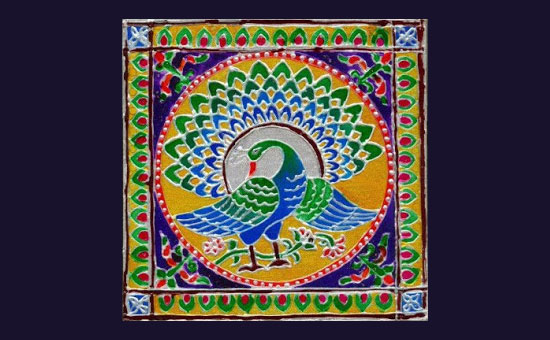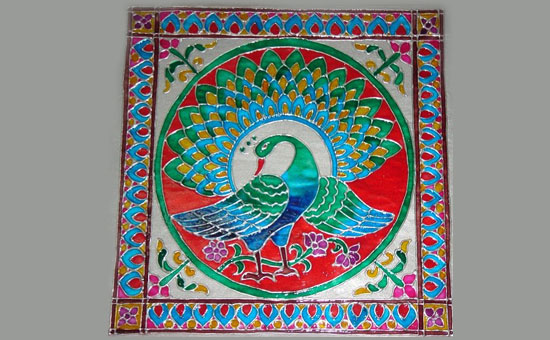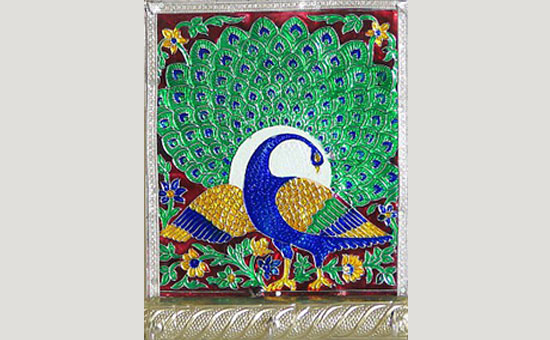- Article tells about the origin of Minakari art, what is the process, approach and application and where it is found in India.
The art of Minakari or Enamelling is called miniature of fire as well as the decoration of metal and tile with mina glaze. Minakari or Enamelling is the art of painting, colouring and ornamenting the surface of metals by fusing over it brilliant colours. These are decorated in an intricate design.
Mina is the feminine form of the Persian
word Minoo meaning heaven. Mina refers to the azure colour of heaven. The
Iranian craftsmen of the Sassanid era invented this art and the Mongols brought
it to India.
French tourist, Jean Chardin who toured
Iran during Safavid rule referred to an enamel work of Isfahan, which comprised
a pattern of birds and animals on a floral background in light blue, green,
yellow and red.
 Minakari work.
Minakari work.
Enamelling is the art of colouring or decorating a metal surface by attaching or fusing pieces of different mineral substances over it. Enamelling is considered the most alluring and technical of all metal decorations. In the past enamelling was only done on gold, but presently it is done on other metals like silver, copper etc.
The art of decorating metal with Enamelling
or Meenakari was alien to India and was introduced by the Mughals. Raja Man
Singh of Amber (Jaipur) brought Meenakari to Rajasthan at the turn of the 16th
century. Man Singh brought skilful Minakars from the Mughal palace at Lahore
and established them in Jaipur, which became the centre of Meenakari.
 Meenakari art.
Meenakari art.
Process
The technique of Meenakari requires a
high degree of skill and application. The piece of metal on which Meenakari is
to be done is fixed on a lac stick. Delicate designs of flowers, birds, fish
etc are etched or engraved on it. This leads to the creation of walls or
grooves, to hold colour. Enamel dust of required colour is then poured into the
grooves and each colour is fired individually. The heat of the furnace melts
the colour and the coloured liquid gets spread equally into the groove. This
process is repeated with each colour.
As each colour is individually fired, colours,
which are most heat resistant, are applied first, as they are re-fired with
each additional colour. As a rule, white is the first colour applied and red
the last.
After the last colour has been fired,
the object is cooled and burnished or polished with agate. The depth of the
grooves filled with different colours determines the play of light.
Both silver and gold can be used as a
base for Meenakari. A limited number of colours, like gold, blue, green and
yellow, stick to silver, whereas all available colours can be applied to gold,
making it the preferred medium of enamellers.
The Meenakar often works with a team of
craftsmen. As Meenakari is generally done on the reverse side of Kundan
jewellery, the Meenakar has to work with the goldsmith, the engraver or
ghaaria, the designer or chitteria and jadiya who apply the gems on the kundan
or gold.
The finished produced is a marvel of
the expertise of these different craftsmen and their techniques.
Occurrence
Jaipur is the main center of Meenakari.
Traditional Mughal colours like red, green and white, dominate the art of enamelling
from Jaipur. The rich, ruby red colour used here is highly sought after.
Nathdwara, Bikaner and Udaipur are also
famous for their silver Meenakari. Pratapgarh is known for glass enamelling.
Delhi and Banaras are also important centres
for Meenakari.
Some experts link the historicity of Enamelling in Iran to the Arsacides and Sassanid periods. However, the use of this art in the Islamic period is not clear before the reign of the seventh ruler of Mongol empire’s Ilkhanid division in Iran, Ghazan Khan (694-703 A.D.) who introduced Mongol Persia to Islam.
Ghazan khan acquired the science of
chemistry in a short period and preferred to use his knowledge and endeavours
for the art of enameling.
Approach
Fine silver is used in almost all enamelling
because the enamel (glass) melts and sticks best to a pure metal. In simple
words, enamelling is the process of making metal models (fine silver usually)
and then melting various colours and types of glass on to the object.
Model to create an objet d’art
In a more scientific approach, enamel
(or vitreous enamel or porcelain enamel in US English) is defined as the colourful
result of fusing powdered glass to a substrate by firing, usually between 750
and 850 degrees Celsius.
The powder melts flows and hardens to a
smooth, durable vitreous coating on metal, glass or ceramic. According to some
sources, the word enamel comes from the High German word Smelzan (to smelt) via
the old French Esmail. Used as a noun, an enamel work is a usually small decorative
object, coated with enamel coating.  Meenakari art.
Meenakari art.
A champlevž or a cloisonnž
The paintings or patterns used for
enamel works in Iran are traditional designs depending on the taste and preferences
of the artist. In the Iranian version of Enamelling, copper and silver are the
most dominant metals used. There are also special tools used in this ancient
artistic endeavour such as furnace, pliers, press machine, brush and so on.
Enamel is usually used to embellish
vase, jewellery and candleholder in addition to doors and chandeliers of holy
shrines. Isfahan is the most important Iranian enamelling hub. Enamel works can
be washed with lukewarm water, soap and even ordinary detergents.
Gold has been used traditionally for Meenakari
jewellery as it holds the enamel better, lasts longer and its lustre brings out
the colours of the enamels. Silver, a later introduction, is used for artefacts
like boxes, bowls, spoons, and art pieces.
While copper which is used for
handicraft products were introduced only after the gold control act, which
compelled the Minakars to look for a material other than gold, was enforced
around the world.
Application
Enamel working and decorating metals
with colourful and baked coats is one of the distinguished courses of art in Isfahan.
Mina, is defined as some sort of glass like
coloured coat which can be stabilized by heat on different metals particularly
copper. Although this course is of abundant use industrially for producing
metal and hygienic dishes, it has been paid high attention by painters,
goldsmiths and metal engravers since centuries ago.
In the world, it is categorized into three kinds as below:
1. Painting enamel.
2. Charkhaneh or chess like enamel.
3. Cavity enamel.
What of more availability in Isfahan is the
painting enamel of which a few have remained in the museums of Iran and abroad
indicting that Iranian artists have been interested in this art and used it in
their metal works since the Achaemenian and the Sassanid dynasties.
The enamels being so delicate, we do
not have many of them left from the ancient times. Some documents indicate that
throughout the Islamic civilization of and during the Seljuk, Safavid and Zand
dynasties there have been outstanding enamelled dishes and materials. Most of the enamelled dishes related to the past belong to the Qajar dynasty between the years 1810–1890 A.D. There have also remained some earrings, bangles, boxes, water pipe heads, vases, and golden dishes with beautiful paintings in blue and green colours from that time, afterwards, fifty years of stagnation caused by the World War I and the social revolution followed.
The enamel red colour was prepared in this art from the quantity and quality points of view through the attempts bestowed by Ostad Shokrollah Sani'e Zadeh, the outstanding painter of Isfahan in 1935.
Conclusion
The technique of this art entails perseverance
and deliberation. In Minakari, an ornament is crafted in silver and then the
artist draws the desired design. It is then outlined by the engraver to make
the enamel adhere firmly to the metal. Enameller then brushes the ornament
on the engraved design with special colours called mina in red, green, black,
yellow, blue etc. A single piece of mina passes through many bands before it
reaches completion.
The intricate geometric design pattern
of Minakari symbolizes various elements of a belief structure that has been
evolved since the dominance of Mithraism era in the Iranian plateau.
Here the center medallion symbolizes Mithra,
the Sun. After a few years of stagnation, this art has started to continue its
briskness since 1992.
Author is a fine artist based in Mumbai.
The
purpose of this compilation is to document and promote. We have given credits
and reference links in this compilation. In case some are missed, it is not
with malafide intent.
To read all articles by author